Communication in IT Environment: Elements, Factors, and Importance
VerifiedAdded on 2023/01/04
|7
|1475
|73
Essay
AI Summary
This essay delves into the multifaceted nature of communication within the IT environment, emphasizing its critical role in professional success. It begins by outlining the fundamental elements of communication, including the sender, receiver, channel, medium, context, feedback, and noise. The essay then explores the factors that contribute to effective communication, such as communication skills, knowledge level, and attitude. A significant portion of the essay is dedicated to intercultural communication, detailing its importance in a globalized IT landscape, the elements involved (perception, verbal, nonverbal, and contextual processes), and its role in overcoming communication barriers. Furthermore, the essay highlights the significance of technological communication, showcasing its benefits in promoting collaboration, efficiency, and opportunity within the IT sector. The essay concludes by reiterating the importance of both intercultural and technological communication for success in the professional IT environment.
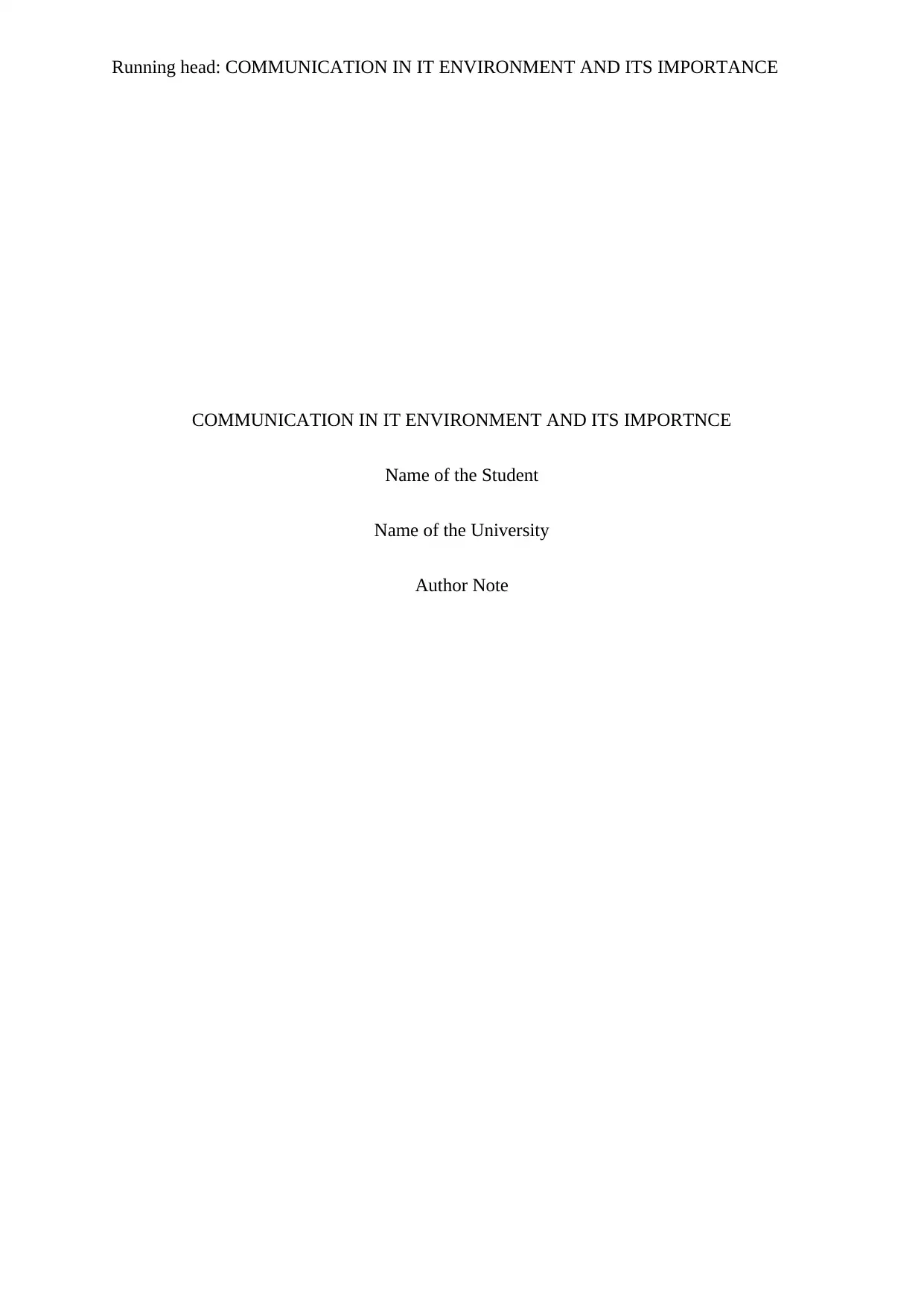
Running head: COMMUNICATION IN IT ENVIRONMENT AND ITS IMPORTANCE
COMMUNICATION IN IT ENVIRONMENT AND ITS IMPORTNCE
Name of the Student
Name of the University
Author Note
COMMUNICATION IN IT ENVIRONMENT AND ITS IMPORTNCE
Name of the Student
Name of the University
Author Note
Paraphrase This Document
Need a fresh take? Get an instant paraphrase of this document with our AI Paraphraser
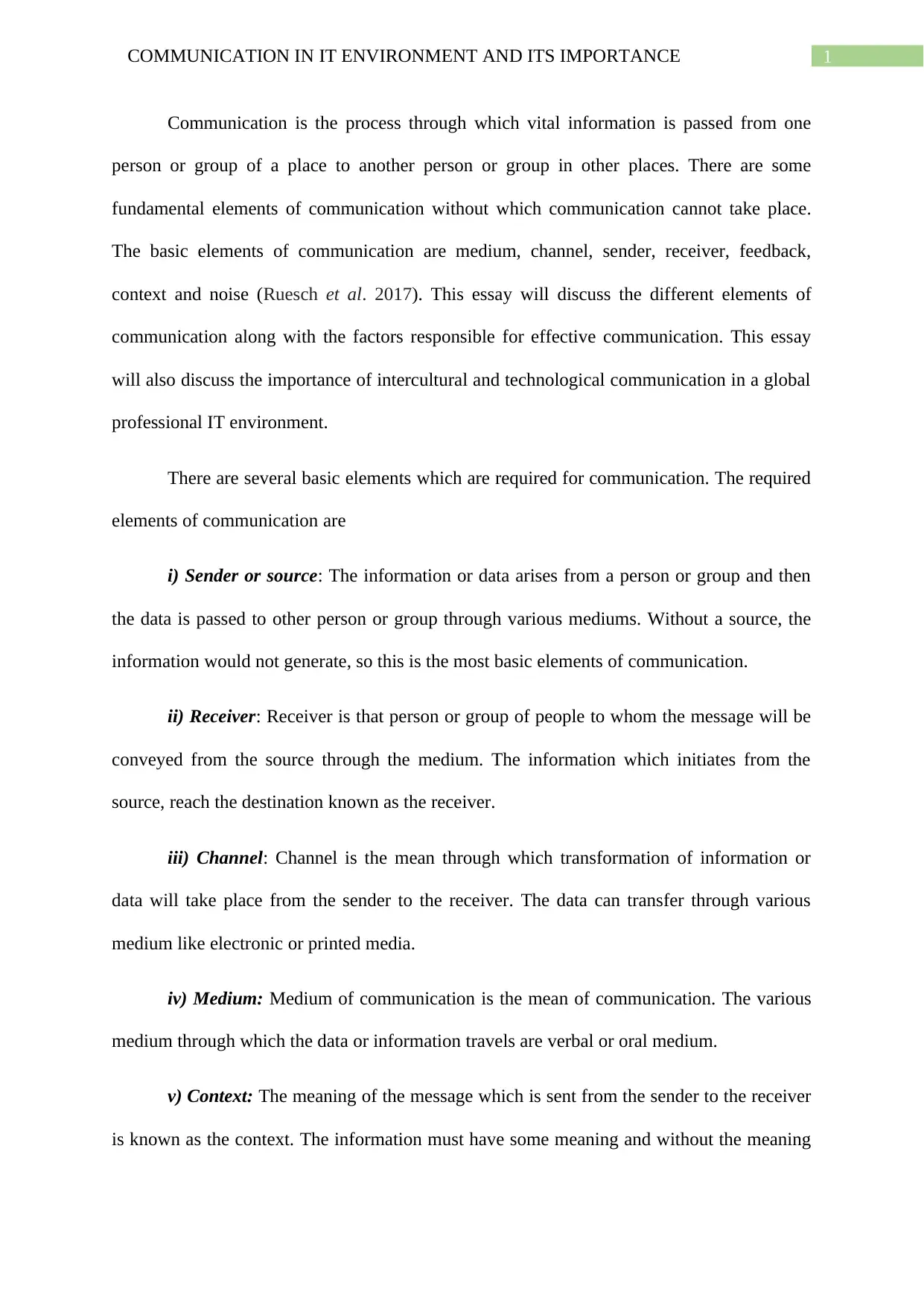
1COMMUNICATION IN IT ENVIRONMENT AND ITS IMPORTANCE
Communication is the process through which vital information is passed from one
person or group of a place to another person or group in other places. There are some
fundamental elements of communication without which communication cannot take place.
The basic elements of communication are medium, channel, sender, receiver, feedback,
context and noise (Ruesch et al. 2017). This essay will discuss the different elements of
communication along with the factors responsible for effective communication. This essay
will also discuss the importance of intercultural and technological communication in a global
professional IT environment.
There are several basic elements which are required for communication. The required
elements of communication are
i) Sender or source: The information or data arises from a person or group and then
the data is passed to other person or group through various mediums. Without a source, the
information would not generate, so this is the most basic elements of communication.
ii) Receiver: Receiver is that person or group of people to whom the message will be
conveyed from the source through the medium. The information which initiates from the
source, reach the destination known as the receiver.
iii) Channel: Channel is the mean through which transformation of information or
data will take place from the sender to the receiver. The data can transfer through various
medium like electronic or printed media.
iv) Medium: Medium of communication is the mean of communication. The various
medium through which the data or information travels are verbal or oral medium.
v) Context: The meaning of the message which is sent from the sender to the receiver
is known as the context. The information must have some meaning and without the meaning
Communication is the process through which vital information is passed from one
person or group of a place to another person or group in other places. There are some
fundamental elements of communication without which communication cannot take place.
The basic elements of communication are medium, channel, sender, receiver, feedback,
context and noise (Ruesch et al. 2017). This essay will discuss the different elements of
communication along with the factors responsible for effective communication. This essay
will also discuss the importance of intercultural and technological communication in a global
professional IT environment.
There are several basic elements which are required for communication. The required
elements of communication are
i) Sender or source: The information or data arises from a person or group and then
the data is passed to other person or group through various mediums. Without a source, the
information would not generate, so this is the most basic elements of communication.
ii) Receiver: Receiver is that person or group of people to whom the message will be
conveyed from the source through the medium. The information which initiates from the
source, reach the destination known as the receiver.
iii) Channel: Channel is the mean through which transformation of information or
data will take place from the sender to the receiver. The data can transfer through various
medium like electronic or printed media.
iv) Medium: Medium of communication is the mean of communication. The various
medium through which the data or information travels are verbal or oral medium.
v) Context: The meaning of the message which is sent from the sender to the receiver
is known as the context. The information must have some meaning and without the meaning
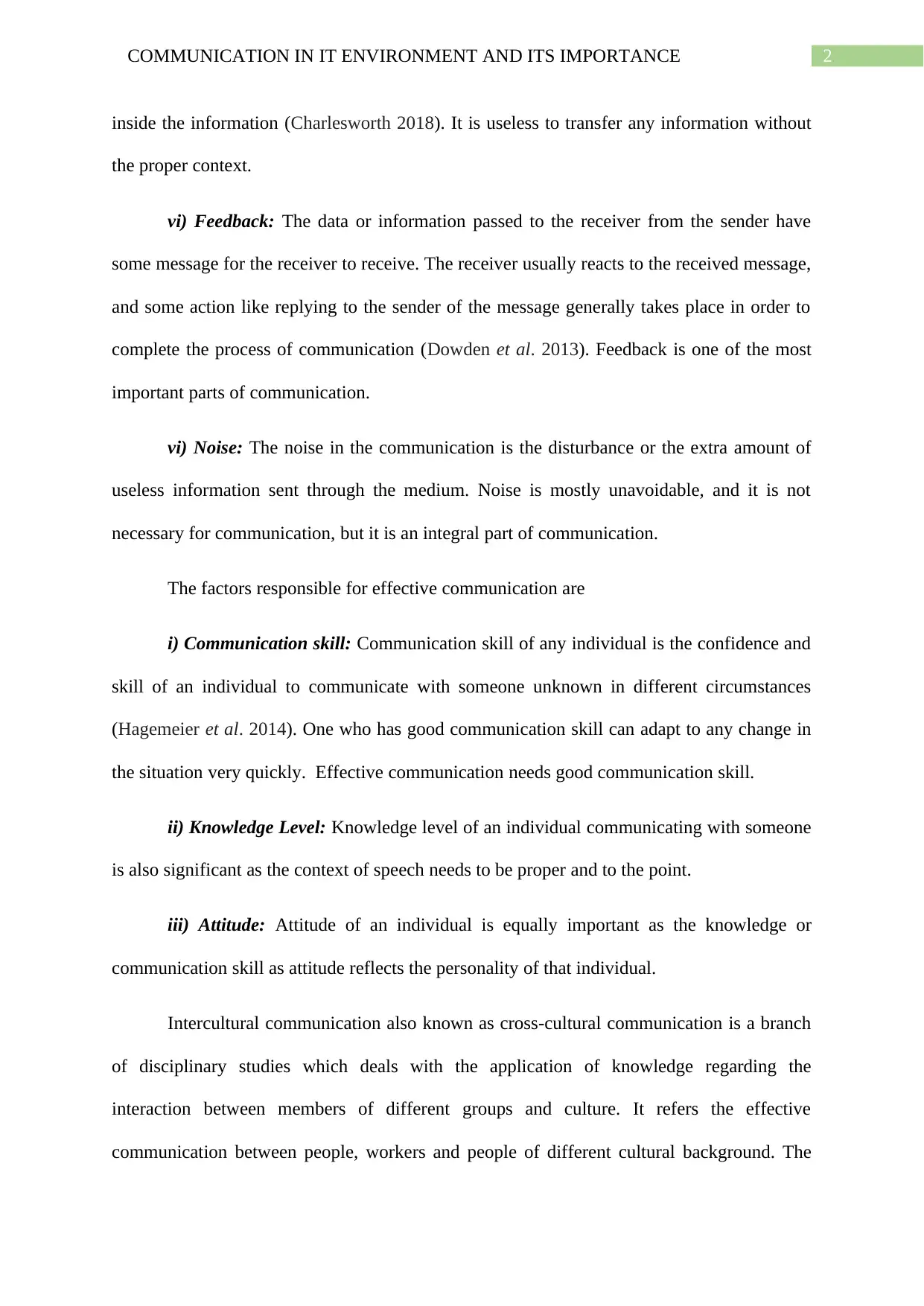
2COMMUNICATION IN IT ENVIRONMENT AND ITS IMPORTANCE
inside the information (Charlesworth 2018). It is useless to transfer any information without
the proper context.
vi) Feedback: The data or information passed to the receiver from the sender have
some message for the receiver to receive. The receiver usually reacts to the received message,
and some action like replying to the sender of the message generally takes place in order to
complete the process of communication (Dowden et al. 2013). Feedback is one of the most
important parts of communication.
vi) Noise: The noise in the communication is the disturbance or the extra amount of
useless information sent through the medium. Noise is mostly unavoidable, and it is not
necessary for communication, but it is an integral part of communication.
The factors responsible for effective communication are
i) Communication skill: Communication skill of any individual is the confidence and
skill of an individual to communicate with someone unknown in different circumstances
(Hagemeier et al. 2014). One who has good communication skill can adapt to any change in
the situation very quickly. Effective communication needs good communication skill.
ii) Knowledge Level: Knowledge level of an individual communicating with someone
is also significant as the context of speech needs to be proper and to the point.
iii) Attitude: Attitude of an individual is equally important as the knowledge or
communication skill as attitude reflects the personality of that individual.
Intercultural communication also known as cross-cultural communication is a branch
of disciplinary studies which deals with the application of knowledge regarding the
interaction between members of different groups and culture. It refers the effective
communication between people, workers and people of different cultural background. The
inside the information (Charlesworth 2018). It is useless to transfer any information without
the proper context.
vi) Feedback: The data or information passed to the receiver from the sender have
some message for the receiver to receive. The receiver usually reacts to the received message,
and some action like replying to the sender of the message generally takes place in order to
complete the process of communication (Dowden et al. 2013). Feedback is one of the most
important parts of communication.
vi) Noise: The noise in the communication is the disturbance or the extra amount of
useless information sent through the medium. Noise is mostly unavoidable, and it is not
necessary for communication, but it is an integral part of communication.
The factors responsible for effective communication are
i) Communication skill: Communication skill of any individual is the confidence and
skill of an individual to communicate with someone unknown in different circumstances
(Hagemeier et al. 2014). One who has good communication skill can adapt to any change in
the situation very quickly. Effective communication needs good communication skill.
ii) Knowledge Level: Knowledge level of an individual communicating with someone
is also significant as the context of speech needs to be proper and to the point.
iii) Attitude: Attitude of an individual is equally important as the knowledge or
communication skill as attitude reflects the personality of that individual.
Intercultural communication also known as cross-cultural communication is a branch
of disciplinary studies which deals with the application of knowledge regarding the
interaction between members of different groups and culture. It refers the effective
communication between people, workers and people of different cultural background. The
⊘ This is a preview!⊘
Do you want full access?
Subscribe today to unlock all pages.

Trusted by 1+ million students worldwide
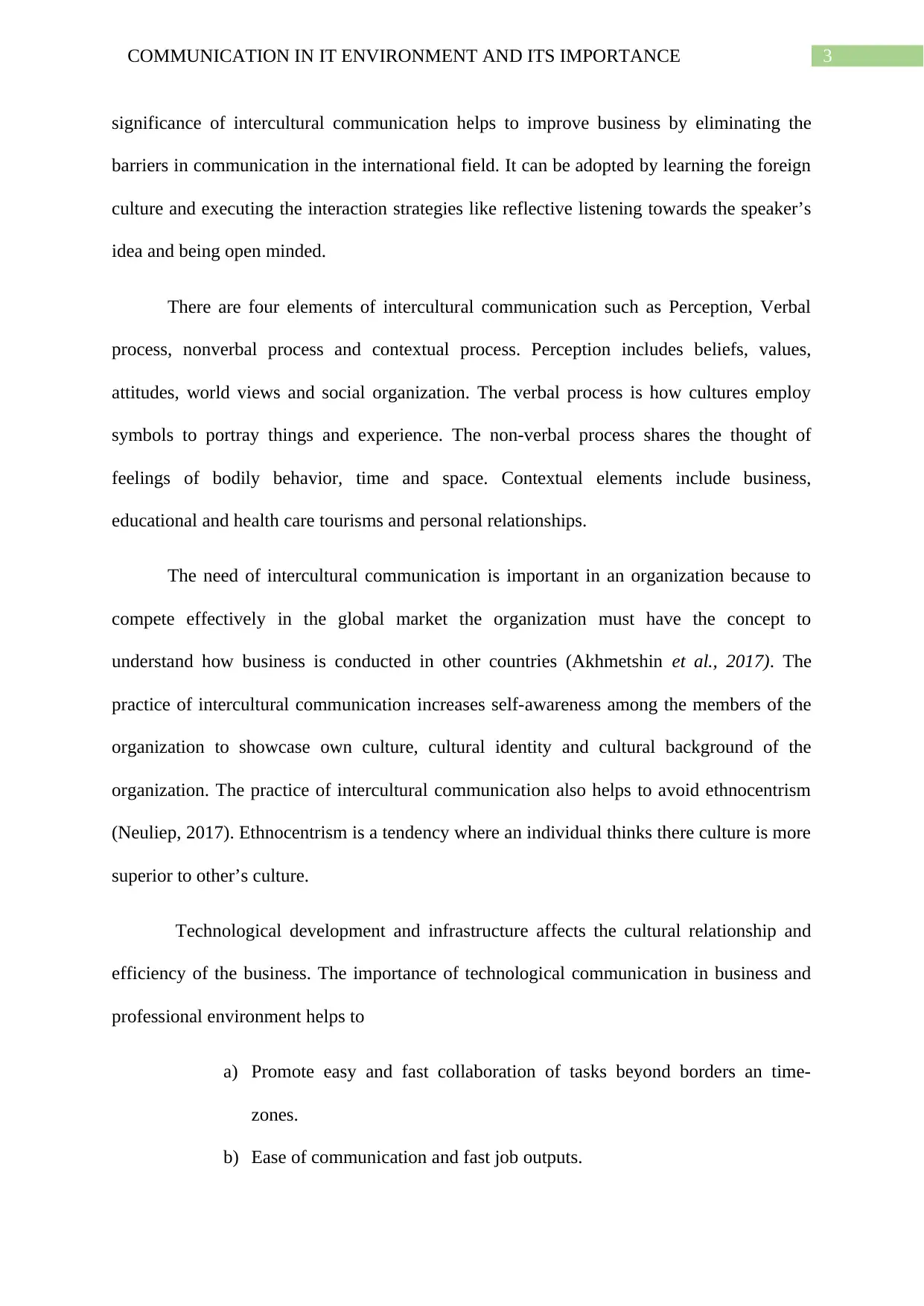
3COMMUNICATION IN IT ENVIRONMENT AND ITS IMPORTANCE
significance of intercultural communication helps to improve business by eliminating the
barriers in communication in the international field. It can be adopted by learning the foreign
culture and executing the interaction strategies like reflective listening towards the speaker’s
idea and being open minded.
There are four elements of intercultural communication such as Perception, Verbal
process, nonverbal process and contextual process. Perception includes beliefs, values,
attitudes, world views and social organization. The verbal process is how cultures employ
symbols to portray things and experience. The non-verbal process shares the thought of
feelings of bodily behavior, time and space. Contextual elements include business,
educational and health care tourisms and personal relationships.
The need of intercultural communication is important in an organization because to
compete effectively in the global market the organization must have the concept to
understand how business is conducted in other countries (Akhmetshin et al., 2017). The
practice of intercultural communication increases self-awareness among the members of the
organization to showcase own culture, cultural identity and cultural background of the
organization. The practice of intercultural communication also helps to avoid ethnocentrism
(Neuliep, 2017). Ethnocentrism is a tendency where an individual thinks there culture is more
superior to other’s culture.
Technological development and infrastructure affects the cultural relationship and
efficiency of the business. The importance of technological communication in business and
professional environment helps to
a) Promote easy and fast collaboration of tasks beyond borders an time-
zones.
b) Ease of communication and fast job outputs.
significance of intercultural communication helps to improve business by eliminating the
barriers in communication in the international field. It can be adopted by learning the foreign
culture and executing the interaction strategies like reflective listening towards the speaker’s
idea and being open minded.
There are four elements of intercultural communication such as Perception, Verbal
process, nonverbal process and contextual process. Perception includes beliefs, values,
attitudes, world views and social organization. The verbal process is how cultures employ
symbols to portray things and experience. The non-verbal process shares the thought of
feelings of bodily behavior, time and space. Contextual elements include business,
educational and health care tourisms and personal relationships.
The need of intercultural communication is important in an organization because to
compete effectively in the global market the organization must have the concept to
understand how business is conducted in other countries (Akhmetshin et al., 2017). The
practice of intercultural communication increases self-awareness among the members of the
organization to showcase own culture, cultural identity and cultural background of the
organization. The practice of intercultural communication also helps to avoid ethnocentrism
(Neuliep, 2017). Ethnocentrism is a tendency where an individual thinks there culture is more
superior to other’s culture.
Technological development and infrastructure affects the cultural relationship and
efficiency of the business. The importance of technological communication in business and
professional environment helps to
a) Promote easy and fast collaboration of tasks beyond borders an time-
zones.
b) Ease of communication and fast job outputs.
Paraphrase This Document
Need a fresh take? Get an instant paraphrase of this document with our AI Paraphraser
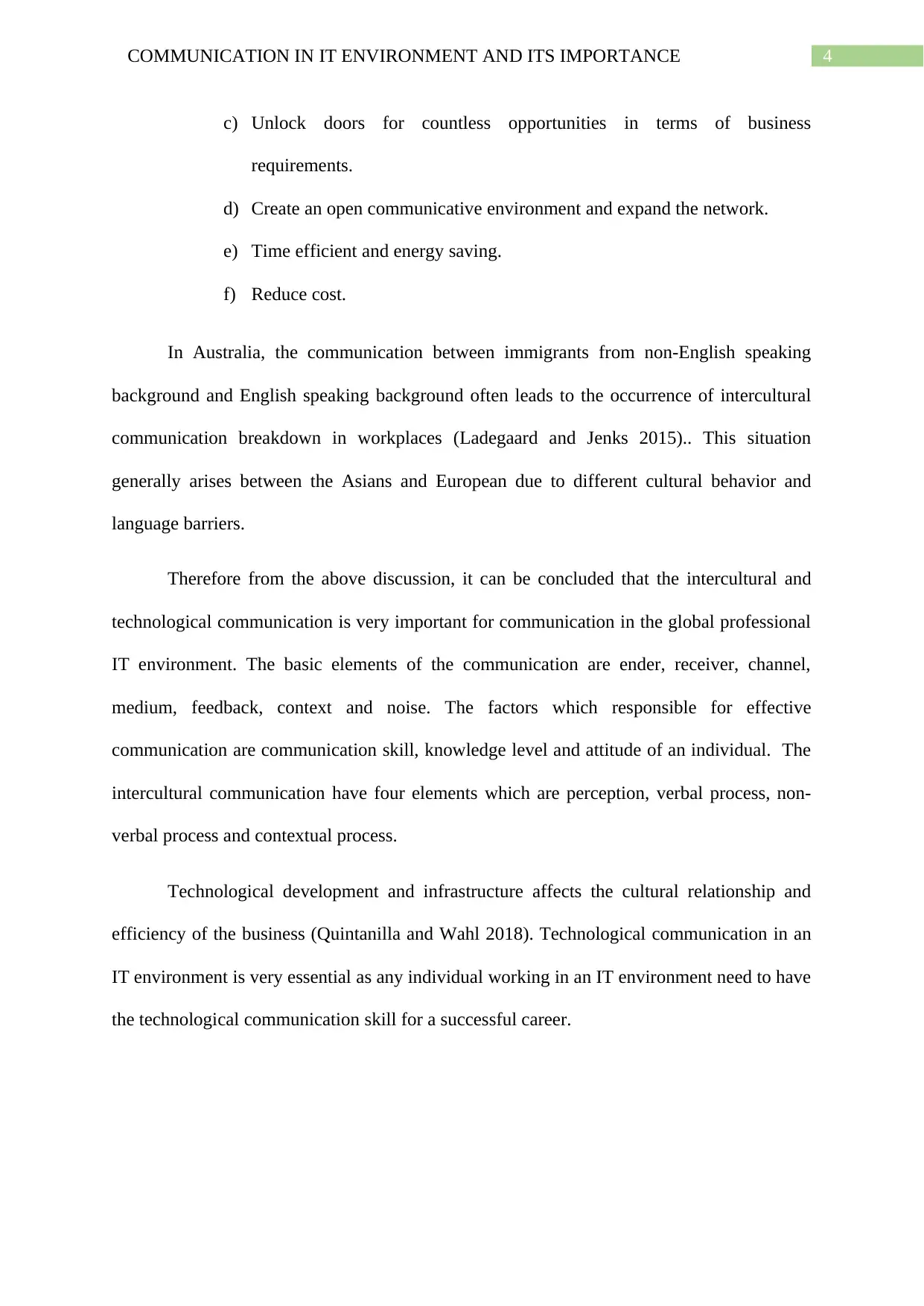
4COMMUNICATION IN IT ENVIRONMENT AND ITS IMPORTANCE
c) Unlock doors for countless opportunities in terms of business
requirements.
d) Create an open communicative environment and expand the network.
e) Time efficient and energy saving.
f) Reduce cost.
In Australia, the communication between immigrants from non-English speaking
background and English speaking background often leads to the occurrence of intercultural
communication breakdown in workplaces (Ladegaard and Jenks 2015).. This situation
generally arises between the Asians and European due to different cultural behavior and
language barriers.
Therefore from the above discussion, it can be concluded that the intercultural and
technological communication is very important for communication in the global professional
IT environment. The basic elements of the communication are ender, receiver, channel,
medium, feedback, context and noise. The factors which responsible for effective
communication are communication skill, knowledge level and attitude of an individual. The
intercultural communication have four elements which are perception, verbal process, non-
verbal process and contextual process.
Technological development and infrastructure affects the cultural relationship and
efficiency of the business (Quintanilla and Wahl 2018). Technological communication in an
IT environment is very essential as any individual working in an IT environment need to have
the technological communication skill for a successful career.
c) Unlock doors for countless opportunities in terms of business
requirements.
d) Create an open communicative environment and expand the network.
e) Time efficient and energy saving.
f) Reduce cost.
In Australia, the communication between immigrants from non-English speaking
background and English speaking background often leads to the occurrence of intercultural
communication breakdown in workplaces (Ladegaard and Jenks 2015).. This situation
generally arises between the Asians and European due to different cultural behavior and
language barriers.
Therefore from the above discussion, it can be concluded that the intercultural and
technological communication is very important for communication in the global professional
IT environment. The basic elements of the communication are ender, receiver, channel,
medium, feedback, context and noise. The factors which responsible for effective
communication are communication skill, knowledge level and attitude of an individual. The
intercultural communication have four elements which are perception, verbal process, non-
verbal process and contextual process.
Technological development and infrastructure affects the cultural relationship and
efficiency of the business (Quintanilla and Wahl 2018). Technological communication in an
IT environment is very essential as any individual working in an IT environment need to have
the technological communication skill for a successful career.
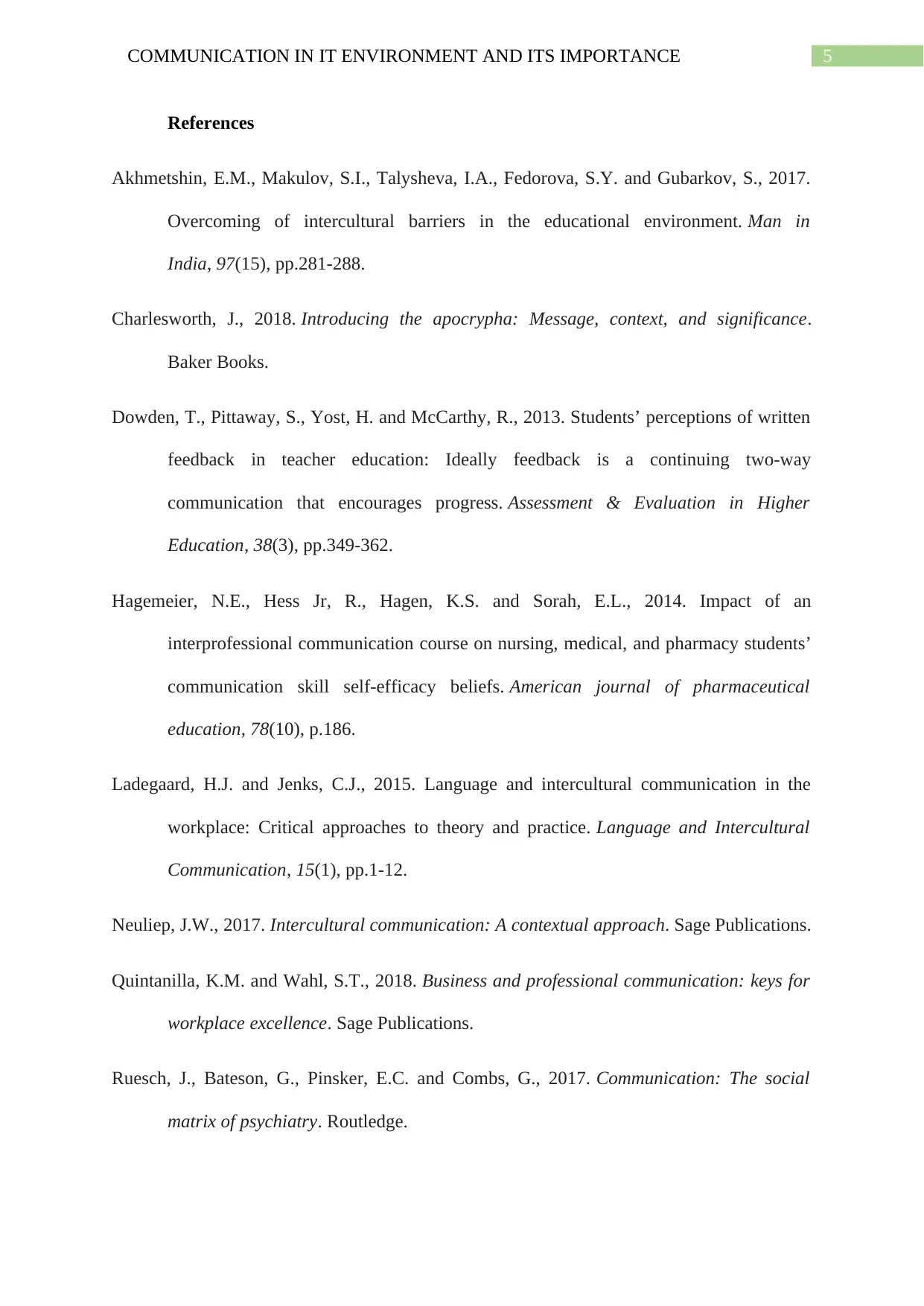
5COMMUNICATION IN IT ENVIRONMENT AND ITS IMPORTANCE
References
Akhmetshin, E.M., Makulov, S.I., Talysheva, I.A., Fedorova, S.Y. and Gubarkov, S., 2017.
Overcoming of intercultural barriers in the educational environment. Man in
India, 97(15), pp.281-288.
Charlesworth, J., 2018. Introducing the apocrypha: Message, context, and significance.
Baker Books.
Dowden, T., Pittaway, S., Yost, H. and McCarthy, R., 2013. Students’ perceptions of written
feedback in teacher education: Ideally feedback is a continuing two-way
communication that encourages progress. Assessment & Evaluation in Higher
Education, 38(3), pp.349-362.
Hagemeier, N.E., Hess Jr, R., Hagen, K.S. and Sorah, E.L., 2014. Impact of an
interprofessional communication course on nursing, medical, and pharmacy students’
communication skill self-efficacy beliefs. American journal of pharmaceutical
education, 78(10), p.186.
Ladegaard, H.J. and Jenks, C.J., 2015. Language and intercultural communication in the
workplace: Critical approaches to theory and practice. Language and Intercultural
Communication, 15(1), pp.1-12.
Neuliep, J.W., 2017. Intercultural communication: A contextual approach. Sage Publications.
Quintanilla, K.M. and Wahl, S.T., 2018. Business and professional communication: keys for
workplace excellence. Sage Publications.
Ruesch, J., Bateson, G., Pinsker, E.C. and Combs, G., 2017. Communication: The social
matrix of psychiatry. Routledge.
References
Akhmetshin, E.M., Makulov, S.I., Talysheva, I.A., Fedorova, S.Y. and Gubarkov, S., 2017.
Overcoming of intercultural barriers in the educational environment. Man in
India, 97(15), pp.281-288.
Charlesworth, J., 2018. Introducing the apocrypha: Message, context, and significance.
Baker Books.
Dowden, T., Pittaway, S., Yost, H. and McCarthy, R., 2013. Students’ perceptions of written
feedback in teacher education: Ideally feedback is a continuing two-way
communication that encourages progress. Assessment & Evaluation in Higher
Education, 38(3), pp.349-362.
Hagemeier, N.E., Hess Jr, R., Hagen, K.S. and Sorah, E.L., 2014. Impact of an
interprofessional communication course on nursing, medical, and pharmacy students’
communication skill self-efficacy beliefs. American journal of pharmaceutical
education, 78(10), p.186.
Ladegaard, H.J. and Jenks, C.J., 2015. Language and intercultural communication in the
workplace: Critical approaches to theory and practice. Language and Intercultural
Communication, 15(1), pp.1-12.
Neuliep, J.W., 2017. Intercultural communication: A contextual approach. Sage Publications.
Quintanilla, K.M. and Wahl, S.T., 2018. Business and professional communication: keys for
workplace excellence. Sage Publications.
Ruesch, J., Bateson, G., Pinsker, E.C. and Combs, G., 2017. Communication: The social
matrix of psychiatry. Routledge.
⊘ This is a preview!⊘
Do you want full access?
Subscribe today to unlock all pages.

Trusted by 1+ million students worldwide

6COMMUNICATION IN IT ENVIRONMENT AND ITS IMPORTANCE
1 out of 7
Related Documents
Your All-in-One AI-Powered Toolkit for Academic Success.
+13062052269
info@desklib.com
Available 24*7 on WhatsApp / Email
![[object Object]](/_next/static/media/star-bottom.7253800d.svg)
Unlock your academic potential
Copyright © 2020–2025 A2Z Services. All Rights Reserved. Developed and managed by ZUCOL.




